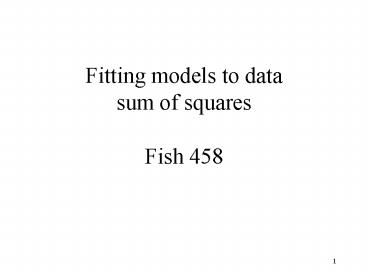Fitting models to data sum of squares Fish 458 - PowerPoint PPT Presentation
1 / 28
Title:
Fitting models to data sum of squares Fish 458
Description:
The Ecological Detective Hilborn and Mangel Chapter 5. 3. Why fit models to data ... we use the data to see how much support there is for competing hypotheses ... – PowerPoint PPT presentation
Number of Views:35
Avg rating:3.0/5.0
Title: Fitting models to data sum of squares Fish 458
1
Fitting models to datasum of squaresFish 458
2
Reading
- The Ecological Detective Hilborn and Mangel
Chapter 5
3
Why fit models to data
- Models are hypotheses about nature
- we use the data to see how much support there is
for competing hypotheses - does your model fit the data?
- Only in comparison to other hypotheses - no real
absolute measure of acceptable fit
4
What is needed
- Competing models
- data
- goodness of fit criterion
- Algorithm to maximize goodness of fit
5
The model, linear regression
6
Some data B.C. herring
7
Goodness of fit
- every value of a and b makes predictions about
the length for each individual - how do we decide what parameters are best
- sum of squares
8
The best fitlinear_growth.xls
9
Sum of squares surface
10
How to find the minimum sum of squares
- direct search (ok for 1-3 parameters)
- algebra (linear regression - linear models)
- non-linear gradient searches
11
What are the competing hypotheses?
- Different values of slope or intercept
- We could expand our analysis to include models
that have shapes other than linear and ask if the
data support them.
12
Schaefer model
13
Why log SSQ
- so that predicted 10 vs observed 20
- has same weight as
- predicted 1 vs observed 2
- Again the multiplicative error assumption
14
New Zealand Lobster
15
Lobster
- The blue dots are the Index (CPUE) divided by q,
the red line is the model fit and the light blue
line is the annual exploitation rate - We fit the CPUE quite well, because that is the
SSQ criterion - But not that it implies a very low exploitation
rate, even though it is known that the
exploitation rate after 1980 was very high, maybe
70
16
An alternative fit with r fixed at 0.5
17
Differences
- We fit the CPUE not as well
- SSQ goes from 1.9 top 3.2
- But now we have much more reasonable estimates of
fishing mortality rate
18
So we have two types of information
- The CPUE series
- The knowledge (from length frequency analysis)
that exploitation rates are high.
19
Problems with SSQ
- how to weight multiple data sources
- how to make probabilistic statements about the
results
20
New Zealand lobster
- previous fit has biomass in 199023,000 tons and
1990 catch2,770 tons which is a harvest rate of
12 - but we know from length frequency that the
exploitation rate was at least 70 through all
the 1980s - add additional SSQ term
21
equal SSQ weighting
22
Equal weighting gives almost no weight to the
exploitation rate data
23
unequal weighting
24
w10
25
Lessons re lobster
- A one-way trip is not very informative
- Harvest and growth are confounded
- We can force the model to have higher
exploitation rates - But the logistic model is, in the end, not very
satisfactory - In NZ the logistic was rejected and a more
complex model fitting to length frequency
allowing for recruitment to be estimated for each
year is now used
26
Extinction risk vs yield
- If our concern is extinction the key question is
what would be the impact of reducing harvest - If our concern is yield the key question is what
would be the impact of reducing harvesting - You cant get away from the confounding of
population rate of increase vs harvesting
27
Summary SSQ
- Make the predicted close to the observed!
- Is a simple approach that can be applied to
simple or very complex models - Find the hypothesis that comes closest to the
data - Also find competing hypotheses that fit data
nearly as well - We always want to understand the fit of competing
hypotheses
28
Next steps
- Many models have many sources of data
- Move to likelihood that provides a logical method
of weighting alternative data sources - Likelihood also lets us make more probabilistic
statements about competing fits































